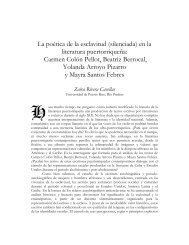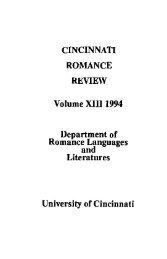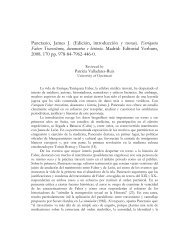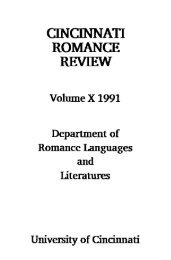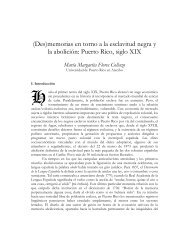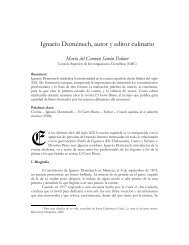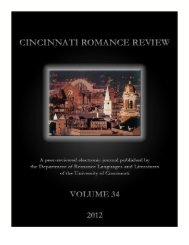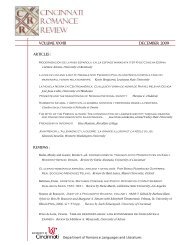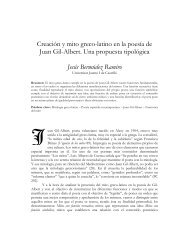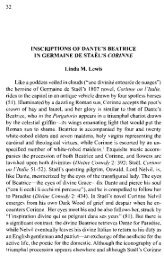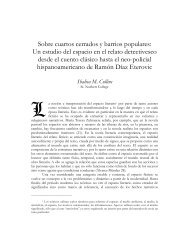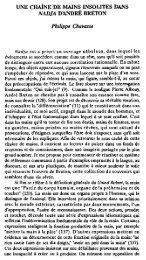Volume 30 (2011) - Cincinnati Romance Review
Volume 30 (2011) - Cincinnati Romance Review
Volume 30 (2011) - Cincinnati Romance Review
Create successful ePaper yourself
Turn your PDF publications into a flip-book with our unique Google optimized e-Paper software.
80 SONJA STEPHENSON WATSON<br />
que canta mi verso!<br />
Raza enorme que estudia<br />
y medita;<br />
raza fuerte que impone sus credos;<br />
y dibuja entre la raza blanca<br />
su veta dorada de anhelos.<br />
¡Es la raza mulata y altiva<br />
que ensalva mi verso!<br />
La que vive sonrisas y rimas<br />
ahogando un recuerdo. (23)<br />
The poet-speaker elevates the mulata race that is defined as ambitious and<br />
enormous. “Canto a la raza mulata” echoes Julia de Burgos’s “Ay, ay, ay” and Guillén’s<br />
“Balada” because they all evoke mestizaje racial, exude a mulato consciousness, and<br />
reinforce the motif of the Hispanic Caribbean as a “crisol de razas,” a region<br />
characterized by numerous races, ethnicities, and cultures but not the racial problems<br />
that accompany this multiplicity. Like “Ay, ay, ay,” this poem clearly evokes the theme<br />
of mulatez portraying the historical evils of the Conquest and the subsequent<br />
enslavement of blacks throughout the African Diaspora as a harmonious aesthetic<br />
union devoid of racial and cultural conflict. “Ay, ay, ay” differs in that it chastises the<br />
white slave master for his lack of moral conscious. Contradicting her statement in the<br />
prologue to Ámbar mulato that Puerto Rico is a jíbaro country i.e. one with strong<br />
indigenous heritage, the poem denotes that Puerto Rico is indeed a mulato nation. Colón<br />
Pellot’s portrayal of Puerto Rico as a “crisol de razas” reflects her bicultural heritage on<br />
the one hand but also the need to conform to the negrista aesthetic on the other. As<br />
Jiménez Muñoz notes, “...ésta es la única forma de entrar en la discusión literaria y<br />
literata sobre la identidad nacional y cultural en general y la discusión sobre raza, en<br />
particular” (78-9).<br />
Colón Pellot’s poetry points to the low esteem of women and their lack of social<br />
mobility. The ability of white women to skirt societal norms plagued her, but it is also<br />
clear that the limitations of women at large stifled her literary and creative potential. In<br />
“Mi verso,” Colón Pellot compares her poetry with her gender. “Este es mi verso/un<br />
verso enfermizo y débil como mi sexo” (5). The poetry is identified with the weakness<br />
and debility of her sexual identity, one characterized by sickness and inferiority. Her race<br />
afforded her little opportunities and coupled with her gender produced conflicts.<br />
Having limited access to the prestigious institutions of the creole elite, she found a<br />
space by subverting the paradigms of negrista literature while appearing to engage them<br />
(Roy-Féquiere “Speaking For” 249). While her mulato poetry has been lauded, she has<br />
frequently been described as a woman “que tenía problemas con la posición de<br />
inferioridad racial que ocupaba en la sociedad puertorriqueña” (Jiménez Muñoz 77).<br />
Clearly, her hybrid racial identity stifled her literary potential.<br />
<strong>Cincinnati</strong> <strong>Romance</strong> <strong>Review</strong> <strong>30</strong> (Winter <strong>2011</strong>): 69-82.



